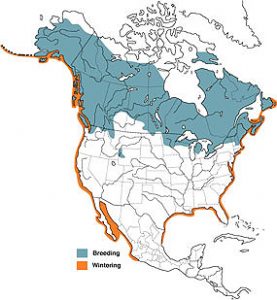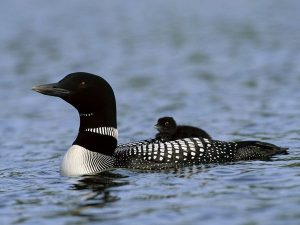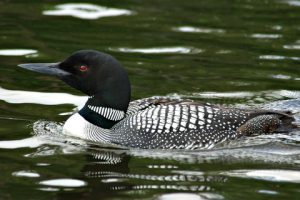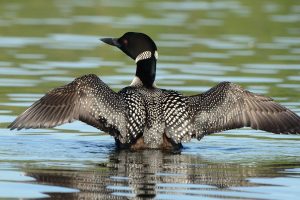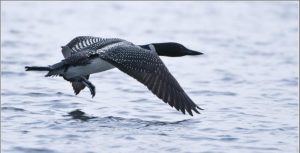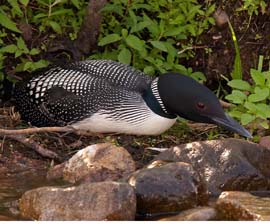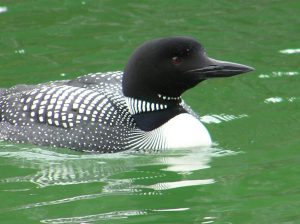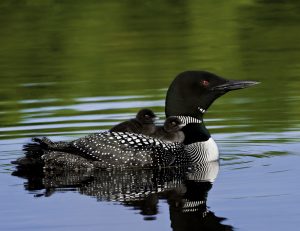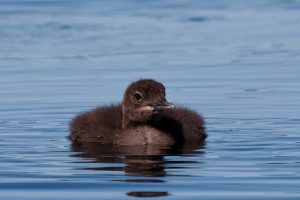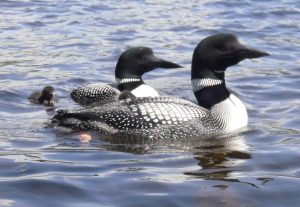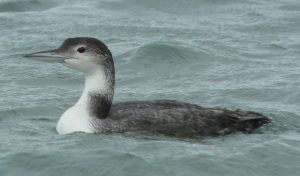Common Loon
Common Loons, formerly known as Great Northern Loons, are migratory aquatic birds with sharp beaks and thick necks.
Scientific Classification
| Kingdom | Animalia |
| Phylum | Chordata |
| Class | Aves |
| Order | Gaviiformes |
| Family | Gaviidae |
| Genus | Gavia |
| Species | Gavia immer |
Quick Information
| Similar Species | Red-throated Loon, Pacific Loon, Double-crested Cormorant |
| Other Names | Loon Duck, Great Northern Diver |
| Size | 61 to 100 cm (24 to 39 in) in length |
| Wingspan | 122 to 152 cm (48 to 60 in) |
| Weight | 1.6 to 8 kg (3.5 to 17.6 lb) |
| Color | A black head, black and white checks at the back feathers, white underparts in breeding adults; brownish plumage with white chin and fore neck in non-breeding adults, the bill is black-blue with strikingly red eyes ; the juveniles have the same plumage as the non-breeders |
| Distribution | Found in Canada and the northern United States in spring and summer; migrate during winter and can be found in Baja California, Texas, and northwestern Europe |
| Habitat | Lakes and other waterways; they come ashore only to nest |
| Lifespan | Around 30 years in the wild on average |
| Diet | They eat mainly fish, especially perch, sunfish, Atlantic Croaker and Gulf Silversides; however, if there is lack of fish or they are unable to catch it, they will feed on frogs, leeches, snails, crustaceans, insect larvae, mollusks and sometimes aquatic plants |
| Adaptations | They have strong bones which make them less buoyant and helps in diving; a sharp backward projection on the top of the mouth and tongue helps them in having a firm grip over their prey |
| Clutch Size | 1 – 2 eggs |
| Egg Size | Length: 8.8 to 9 cm, width: 5.5 to 5.7 cm |
| Number of Broods | 1 |
| Incubation Period | 26 to 29 days |
| Predators | Birds like gulls, ravens, and bald eagles, fish such as pike; land animals like raccoons, skunks, and weasels, bald eagles; marine mammals like sea otter |
| IUCN Conservation Status | Least Concern |
Behavior
Common loons swim underwater to catch their prey and can remain there for as long as three minutes. While in water, they use their feet for propulsion. They prefer large waterways as they need a vast stretch for take-off.
Common Loon call
They make four types of sounds, namely the Tremolo, the Yodel, the Wail, and the Hoot. Tremolo is of short and wavering nature used to signal alarm or to notify their arrival at a lake. They use it during flights only. The yodel is male loon’s claim of a territory, and it changes when the bird travels to a new area. The wail is a long call given back and forth to locate each other’s position whereas hoots are short, soft calls used for making contact with each other.
Breeding and Nesting
Common loons are monogamous birds that mate annually. They start breeding at two years of age, their breeding territory ranging between 60 and 200 acres. Breeding takes place ashore in nest sites, which are generally reused annually. They defend the territories physically as well as vocally, and both, male and female, take part in nest building. The nests are built with dead marsh grasses, twigs, reeds and other plants along the vegetated coasts of lakes.
Life Cycle
Both, male and female incubate the eggs. Chicks leave the nest after few days from hatching and sometimes ride on their parent’s back in the water. Both the parents feed and nurture the babies. In the next 2 to 3 days, the chicks are capable of swimming and diving underwater and can fly when they are 10 to 11 weeks old.
Interesting Facts
- Common loons can dive more than 200 ft (61m) underneath the surface of the water in search of food.
- They can fly at a speed of more than seventy miles per hour especially when they are migrating.
- They are known to be awkward as their legs are placed far back on the body. They are clumsy when on their feet and are more comfortable in water than in land.
- When they are below the surface of water, their heart slows down to preserve oxygen.
- During migration, they sometimes land in wet highways, parking lots, or small ponds, mistaking them to be large water bodies and getting stranded since they require large areas to lift themselves.
- Their plumage exhibits seasonal changes – black and white pattern in summer while it is plain gray above and white below in winter.
References
- https://en.wikipedia.org/wiki/Common_loon
- https://www.allaboutbirds.org/guide/Common_Loon/lifehistory
- https://www.nationalgeographic.com/animals/birds/facts/common-loon
- https://www.desertusa.com/animals/loon.html
- https://www.natureconservancy.ca/en/what-we-do/resource-centre/featured-species/birds/common-loon.html
Published on August 17th 2016 by Sajal Datta under Coniferous Forest Animals.
Article was last reviewed on 17th July 2023.


